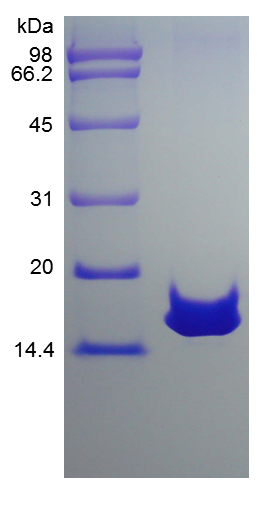- Synonyms
- CCK1
- Source
- Escherichia coli.
- Molecular Weight
- Approximately 13.1 kDa, a single non-glycosylated polypeptide chain containing 116 amino acids.
- AA Sequence
- SEAILPIASS CCTEVSHHIP RRLLERVNSC SIQRADGDCD LAAVILHVKR RRICVSPHNP TLKRWMSASE MKNGKENLCP RKKQDSGKDR KGHTPRKHGK HGTRRIHGTH DHEAPR
- Purity
- > 96 % by SDS-PAGE and HPLC analyses.
- Biological Activity
- Fully biologically active when compared to standard. The biologically active determined by a chemotaxis bioassay using human lymphocytes is in a concentration range of 5.0-50 ng/ml.
- Physical Appearance
- Sterile Filtered White lyophilized (freeze-dried) powder.
- Formulation
- Lyophilized from a 0.2 µm filtered concentrated solution in 20 mM PB, pH 7.4, 200 mM NaCl.
- Endotoxin
- Less than 1 EU/µg of rRtMEC/CCL28 as determined by LAL method.
- Reconstitution
- We recommend that this vial be briefly centrifuged prior to opening to bring the contents to the bottom. Reconstitute in sterile distilled water or aqueous buffer containing 0.1 % BSA to a concentration of 0.1-1.0 mg/ml. Stock solutions should be apportioned into working aliquots and stored at ≤ -20 °C. Further dilutions should be made in appropriate buffered solutions.
- Stability & Storage
- Use a manual defrost freezer and avoid repeated freeze-thaw cycles.
- 12 months from date of receipt, -20 to -70 °C as supplied.
- 1 month, 2 to 8 °C under sterile conditions after reconstitution.
- 3 months, -20 to -70 °C under sterile conditions after reconstitution.
- Usage
- This material is offered by Shanghai PrimeGene Bio-Tech for research, laboratory or further evaluation purposes. NOT FOR HUMAN USE.
- SDS-PAGE

- Reference
- 1. Wang W, Soto H, Oldham ER, et al. 2000. J Biol Chem, 275: 22313-23.
2. Hieshima K, Ohtani H, Shibano M, et al. 2003. J Immunol, 170: 1452-61.
3. Eksteen B, Miles A, Curbishley SM, et al. 2006. J Immunol, 177: 593-603.
4. Kagami S, Kakinuma T, Saeki H, et al. 2005. J Invest Dermatol, 124: 1088-90.
- Background
- CCL28 belongs to CC family chemokine, also named mucosae-associated epithelial chemokine (MEC). The CCL28 mRNA is highly expressed by epithelial cells of diverse tissues including normal and pathological colon, salivary gland, mammary gland, trachea and rectum. The protein signals through CCR3 and CCR10, and chemotactic for resting CD4, CD8 T-cells and eosinophils. CCL28 shares the most homology with CCL27/CTACK.







 COA申请
COA申请
